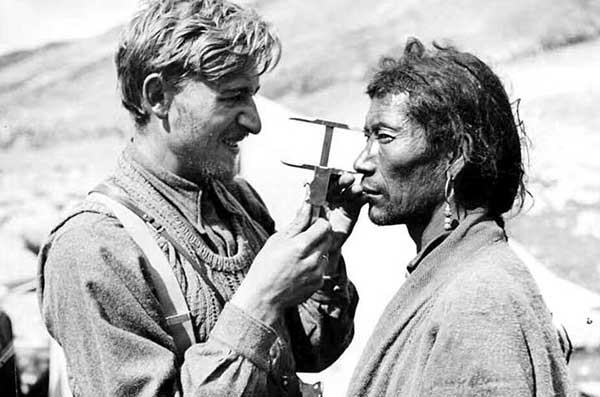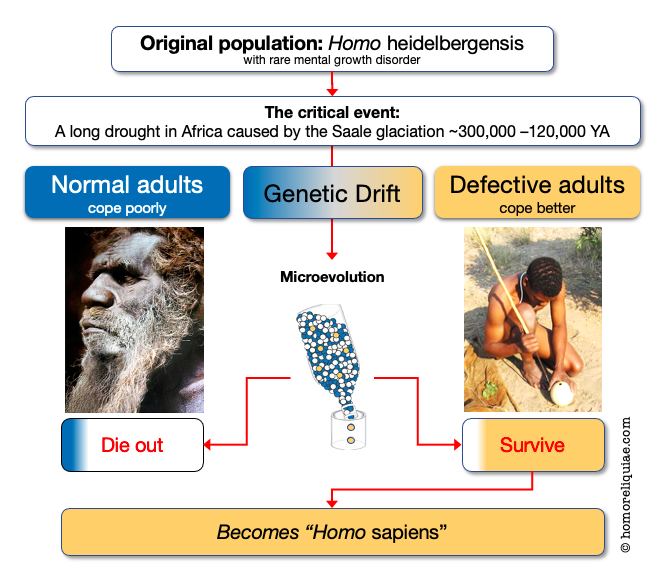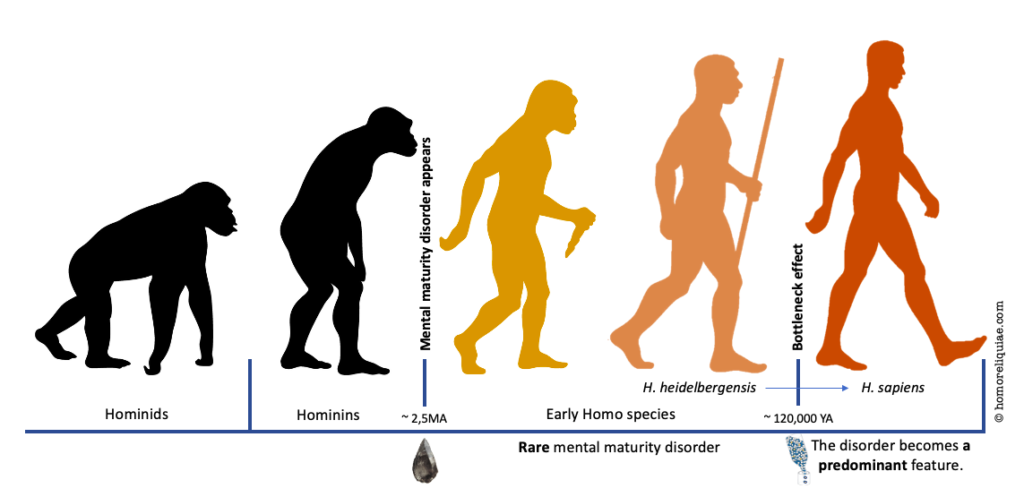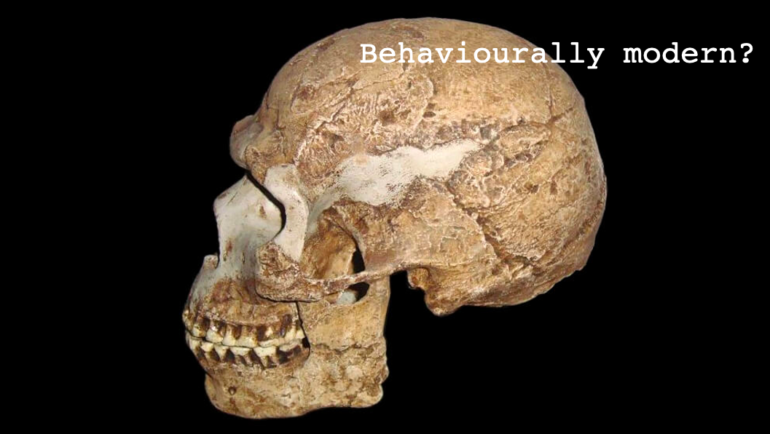Meanwhile, in Africa
Dry and cracked land where nothing grows anymore. Africa probably looked like this after more than 200,000 years of the Saale glaciation about 130.000 years ago. Ice age caused an extended drought during its existence and drove the local homo populations to the brink of extinction. But somehow, some individuals of the Heidelberg population luckily survived. From among these few thousand surviving Heidelbergs grew the ancestors of modern people. How on earth did a handful of Heidelbergs turn into modern humans? This question is one of the great mysteries of science. The roots of the human species are in this particular event! What happened in Africa during the long ice age of +120.000 years ago?
Stone tools are the clue

A “smoking gun”? Do stone tools reveal a genetic defect? The psyche doesn’t remain visible in fossils but appears indirectly in stone tools. However, in human evolution, stone tools cannot be interpreted as a species trait but only a feature of a few genetically divergent and unadaptable individuals. The exceptional nature of the stone tools also explains their gradual evolution. Therefore, species cannot be defined by tool findings. For modern humans, all individuals are abnormally divergent.
“Mentally modern human”?
The key to human speciality is not anatomical and, therefore, not directly found either in fossils of early species or in the bodies of living people. Instead, the key is so well hidden in the psyche that even scientific research has so far not recognised it. The key is inheritable due to a rare genetic disorder of the mind. The hereditary nature of the illness explains how the trait could be rare and relatively insignificant and then surprisingly turn into a dominant one. However, it is not rare anymore. On the contrary, it’s all over and maybe too common to attract our attention.
It would probably be helpful to introduce the term mentally modern human (MMH) and use it instead of anatomically modern human (AMH). The emergence of anatomically modern humans (AMH) is a part of the long developmental cycle in which the importance of childhood has begun to be emphasised more strongly. Shifting focus from anatomy to psyche allows for a more explicit determination of the chain of events of the emergence of modern humans.

An anthropologist measures the anatomical features of a non-European man. Human speciality is still more psychological than anatomical and cannot be seen only with eyes. It is also good to recognise the chance that the juvenile-like psyche may have affected our exteriors, such as body structure or childlike facial features, rather than vice versa. Nevertheless, the adolescent mind already existed well before we became fully anatomically modern humans.
The strange survival
The mysterious incubator of the human revolution was undoubtedly the ice age of over 200,000 years. It was the so-called Saale glaciation. In the northern hemisphere, glaciation trapped water in thick layers of ice, creating a long and devastating drought in Africa. The drought is known to have reduced the population of the Heidelbergs to only a few thousand individuals, i.e. virtually to the brink of extinction. About 120,000 years ago, the glaciation was pretty much over. As the ice receded, the population was still there, but barely the same size as the number of orangutans today.
We know that such a small community inevitably meant declining genetic diversity, which would have diminished survival chances. But strangely enough, this never happened. Instead, among the few thousand surviving Heidelbergs grew the first modern humans. Research has not found an answer to how this happened. Scientists have only stated that the “most viable” individuals, who survived the crisis, multiplied and eventually spread throughout the globe. The answer seems traced to the hitherto unexplored process in which the recessive trait became dominant.
The exception became the norm
How we became modern humans: The emergence of Homo sapiens means a gene defect multiplied by the bottleneck effect. The spread of the hereditary defect was facilitated by a prolonged drought in Africa about +120,000 years ago. It killed off normal individuals more effectively and eventually for good than defective ones, who could exploit their juvenile-like imagination and intellect. Thus, natural selection had nothing to do with the emergence of the modern human as a species. Instead, modern humans emerged because they could avoid the effects of natural selection. Therefore, the notion of superior human adaptability is a myth—on the contrary, humans force the world to adapt to their mental disorder.
Genetic drift
Evolution works in many ways. Natural selection and mutation tendency are two of them. However, our recent development cannot be only explained by these. We have one option: genetic drift. It is one of the mechanisms of evolution. It means a change in the genetic composition due to the random transfer of genes involved in the reproduction process. This type of microevolution refers to evolutionary changes within species, and it can happen, for example, due to a bottleneck phenomenon. We know that man did not arise from scratch in Africa but is a descendant of the Heidelbergs.
So the transformation of the Heidelbergs into a modern human community probably meant that the individuals with a hereditary growth disorder were the only ones who survived the drought. In other words, all of their typically developing partners died. The extinction of our ordinary ancestors meant the birth of modern humans as “a half species”. As the defected individuals outbred normal Heidelbergs, the recessive trait soon superseded the original, dominant trait. And when the dominant feature finally disappeared, the population became fully “domesticated”. And that meant the juvenile-like psyche becoming the new normal. It also marked the only significant difference between the early human species and modern humans: the permanent child-like consciousness.

Bushmen bury ostrich eggs with water inside. They use the same method as our predecessors with a growth disorder. The emergence of modern humans +120,000 years ago didn’t mean a new species because it merely was the intensification and concentration of the old trait. It seemed as though the child’s mind of the early homo species had begun to rebel against its adulthood and refused to develop typically. The disorder was reflected in behaviour as people sheltered themselves from nature using stone tools, fire, clothing, and travelling.
The surviving Heidelbergs gradually formed a more homogeneous population which would be the basis of the modern human population. Its genetic lineage became narrower than that of normal Heidelbergs. Modern humans were not a result of natural selection but due to genetic drift caused by environmental crises. One might ask whether homo sapiens could be called a new species at all. At least, it did not change at the species level. What only changed was the status of the abnormality: it became the new normal. Unadaptableness kept the new Heidelberg-sapiens alive, but at the same time, it isolated them from nature and halted their evolution. Clinging to humanity caused a constant struggle against nature and also against all regular changes in personality. We were locked in the cage of childhood.
Long story short
The two critical milestones in making the modern human mind: The first signs of human-like activity and spirit can be traced back to 2.5 million years. However, we can only talk about humans when all the mentally healthy Heidelbergs die. That happened under the influence of the ice age more than 120,000 years ago. Please note that the image does not represent human development.! It is just suitable as a temporal reference of the disorder.
- The mental growth disorder | The gradual spread among homo species began possibly as long as 3,2 million years ago, but at least 2,5 million years ago. It started as a recessive trait, meaning it was rare and carried only by a few individuals. Thus, already the first stone tools reflect the complete growth disorder. The disorder can also be seen in fire making, clothing and the early human migrations out of Africa.
- The bottleneck effect | The mental growth disorder of homo species remained relatively small in quantitative terms until the devastating environmental conditions in Africa led to its increase in Heidelberg’s population +120,000 years ago. The massive drought caused by the Ice Age in the northern hemisphere made the regular dominant feature of our genome disappear. Thus, homo sapiens is not the result of natural selection but genetic drift. According to general knowledge, “genetic drift may cause gene variants to disappear completely and thereby reduce genetic variation. It can also cause initially rare alleles to become much more frequent and even fixed”. This seems to have happened in Africa, i.e. the dominant trait/gene disappeared, and the recessive trait/gene became dominant. According to this, the hypothesis of the multiregional evolution of modern humans seems unlikely true.
NEWS
PNAS July 20, 2021 | Huge volcanic eruption disrupted climate but not human evolution
Indeed, it seems that human emergence, according to science, has had to take place before the eruption of the Toba volcano ∼ 74,000 y ago.





